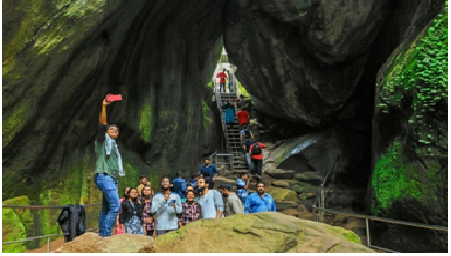Edakkal Caves
The Edakkal Caves are a pair of natural caves located on Ambukutty Mala, about 1,200 meters above sea level, in the Wayanad district of Kerala, India.
These caves are renowned for their ancient petroglyphs and cave paintings that date back at least to 6,000 BCE, placing them among the oldest known human settlements in South India.
Formation: The caves are actually a large fissure or cleft formed by a natural rock split, with a massive boulder wedged between two rock masses, forming a roof.
Discovery: The caves were discovered in the late 19th century (between 1890 and 1895) by Fred Fawcett, then Superintendent of Police of the Malabar district, He recognized their archaeological importance and publicized the findings.
Historical Significance:
- The cave paintings and carvings include images of humans, animals, tools, ancient symbols, and scripts like Tamil-Brahmi, reflecting multiple periods—the Neolithic, Mesolithic, and possibly links to the Indus Valley Civilization.
- Some engravings may be as old as 8,000 years, making them exceptionally rare for South India.
- The diversity of the engravings suggest that the Edakkal caves were inhabited several times at different points in history.
- The Muniyaras, or ancient burial sites that have been discovered in these hills have yielded a rich collection of ancient earthenware and pottery
What is Mesolithic Age?
The Mesolithic Age, also known as the Middle Stone Age, is a prehistoric period that falls between the Paleolithic (Old Stone Age) and the Neolithic (New Stone Age) periods. This time period is generally considered to have occurred between approximately 10,000 and 6,000 years ago, although these dates can vary by region.
Download Pdf




